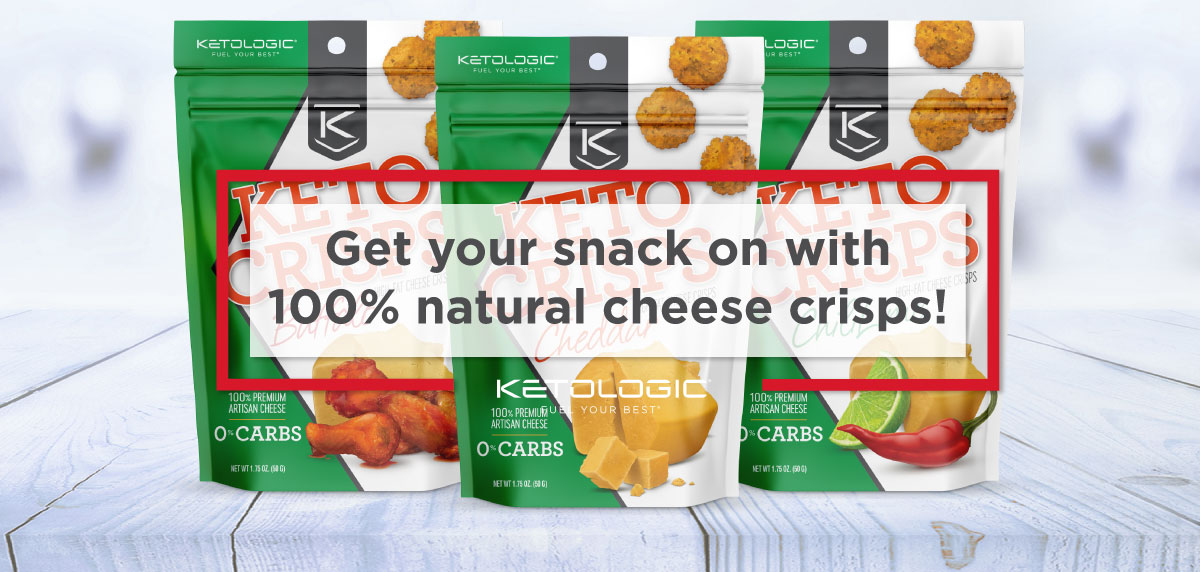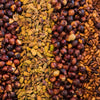The Keto Food Pyramid: Debunking the Top 4 Myths to Set You Up for Success

The ketogenic diet is all the rage right now, and rightfully so, due to the many health benefits associated with this way of eating. Eating a low-carb (5%), moderate-protein (20%), and high-fat (75%) diet has helped many people lose weight, feel more energized, and improve health markers (such as lowered blood glucose, improved cholesterol, and lowered blood pressure) [1, 2, 3]. The downside of keto's growing popularity is that people are hearing misinformation that could prevent them from trying this therapeutic diet, or could cause them to do it incorrectly.
But before scaling the food pyramid, do us a favor and download our Master Keto Food List with 100+ keto foods mapped out for you. It will make shopping for a keto diet soo much easier.
Our keto food pyramid, full of a wide variety of nutrient-dense whole foods that all fit perfectly into the ketogenic lifestyle, will help debunk some common keto myths.

Myth #1: Eating fat makes you fat.
This is probably the most common misconception and it comes from years and years of marketing support for low-fat products. The research shows this is simply not true. It’s processed high-carb and sugar-laden foods that cause weight gain and the health complications associated with obesity. Once you eliminate the processed carbs and sugars, and switch to high-quality fats in foods like avocados, salmon, and full-fat dairy, your body stops storing all the excess glucose (coming from a higher-carb diet) as body fat. Moreover, eating fat keeps you satiated, curbs cravings, and naturally suppresses your appetite, so you’re likely to consume fewer calories overall. And as you continue, your body eventually transitions into ketosis, where it begins to use fat to produce ketones for fuel, providing improved energy and mental clarity [4].And don’t think you have to eat meat in order to be keto. While animal products are a good source of saturated fats, there are a slew of plant-based fat sources to include in a well-balanced and diverse ketogenic diet. Five out of six foods on the base of our Keto Food Pyramid do NOT come from animal sources and are amazing sources of both saturated and unsaturated fats.
Olive Oil. A pure source of dietary fat, olive oil provides heart healthy monounsaturated fat and has a variety of uses. Its high smoke point makes it great for frying and sautéing foods while its rich flavor also makes it ideal for drizzling over salads, non-starchy veggies, meats and fish.
Macadamia Nuts and Oil. These little guys are the ideal keto snack. They have a higher proportion of fat to protein+carb than any other nut, making them ideal for ketone production. Plus, they are darn tasty. For an all-natural, on-the-go, keto-friendly snack, try FBOMB Macadamia Nut Butter. Great for traveling, hiking, endurance sports, or even fighting that afternoon workday slump, they are a delicious and convenient complement to your keto lifestyle.
Avocados. A true superfood and nutrition powerhouse, avocados are another great source for monounsaturated fat and an excellent option for vegetarians and vegans living a ketogenic lifestyle. As if that’s not enough - avocados also contain high amounts of fiber (to promote gut health), vitamin C, and potassium (an electrolyte)! Insider tip: to help prevent symptoms of keto flu, which mainly comes from dehydration, snack on an avocado sprinkled with salt. So tasty, and no prep required!
Coconut Oil. A 100% source of saturated fat, vegan-friendly, and insanely versatile, coconut oil contains more MCTs (medium chain triglycerides) than any other food source. MCTs are a key part of the ketogenic lifestyle because they are converted rapidly into ketones for energy. Similar to olive oil and ghee, coconut oil has a high smoke point, making it ideal for cooking. Plus, its flavor will add variety to your meals.
MCT Oil (not pictured). The ultimate keto energy source, MCTs are found in both oil and powder form. As the fat source most efficiently converted into ketones in the liver, they promote ketosis and increase energy and mental clarity. If you’re pressed for time or need something to-go, a convenient and satiating MCT powder shake that supports ketosis is KetoLogic® KetoMeal®. If you prefer the oil form, consider KetoLogic® MCT Oil (16oz bottle) and FBOMB MCT Oil (1-ounce portable packet).
Myth #2: You can eat as much protein as you want on a ketogenic diet as long as you keep your carbs low.
One of the most common keto rookie mistakes is to eat too much protein. Excessive protein results in gluconeogenesis. This causes your body to convert excess amino acids (proteins) into glucose [5], which will prevent ketosis (a.k.a. fat-burning mode). Most people have a threshold of around 25-30 grams per meal, with the exception of extremely muscular individuals. A ketogenic diet isn't a low-carb, high-protein way of eating. Fat needs to be your primary fuel source and that means finding pure-fat sources that don't include protein, such as butter or ghee and the foods listed above. When you do eat meat, fish, or other sources of protein, always choose higher-fat options such as the foods pictured on Row 2 of our Keto Food Pyramid.Eggs. Nature’s perfect protein, eggs contain all 9 essential amino acids as well as a whole host of vitamins and minerals not found in many protein sources, including vitamin E (making them great for your skin, hair, and nails). Free-range eggs will have the highest nutrient levels and greater amounts of heart healthy omega-3 fatty acids. Insider tip: Eggs aren’t just for breakfast! A cheesy omelet filled with sautéed spinach and topped with mashed avocado makes an easy weeknight dinner.
Bacon. Think of bacon as a condiment protein – it’s a delicious addition to dishes to add flavor and fat. Look for pork that is free of hormones, antibiotics, and nitrates.
Salmon. Loaded with omega-3 fatty acids and extremely low in mercury, this fish is the king of anti-inflammatory protein sources. Avoid farm-raised and stick to wild Alaskan varieties for full nutrient benefits. Other great omega-3 sources include sardines, anchovies, and wild tuna packed in oil.
Beef. High in B vitamins, iron, zinc, and collagen, grass-fed higher-fat (80/20 or 85/15) beef is a wonderful protein source as part of a ketogenic lifestyle. Remember, you are what you eat so if the animals we eat have a poor diet, so do we.
Lamb. With a higher proportion of fat to protein than most other red meats, grass-fed lamb adds a deliciously distinct flavor to dishes. Insider tip: Mix ground lamb with feta and mint for a new twist on the standard burger.
Dark Meat Poultry (not pictured). “You are what you eat” also applies to chicken. Aim for free-range poultry that is free of antibiotics and hormones. Always pick skin-on dark meat (thighs, drumsticks, wings). Leave the breast behind!
Myth #3: The ketogenic isn’t sustainable because you will be deficient in vitamins, minerals and fiber.
Done correctly, the keto diet contains all the essential micronutrients (vitamins, minerals and fiber) that your body needs for optimum performance. But how is it possible to avoid fruits and still be healthy? Easy – eat low-carb vegetables that offer all the vitamins and minerals you can get from fruit, minus all the sugar. These superfoods from the middle row of the keto food pyramid deserve to be on your daily menu.Spinach and Arugula. With more phytochemicals (a.k.a. nutrition’s holy grail) than any other green leafy vegetable, arugula is one of the most nutrient-dense foods you can put in your body. Its peppery flavor will add a kick to your typical salad. Added bonus: both spinach and arugula are great sources of calcium and iron, especially for those on a vegan diet.
Herbs and Spices. Another nutritional powerhouse, herbs and spices add complexity and flavor to everyday dishes. Take scrambled eggs to the next level by adding chopped herbs (chives, dill, cilantro, mint) or spices (curry, cumin, garam masala). Insider tip: Make a pesto using herbs, olive oil, macadamia nuts, and Parmesan to add delicious fat macros to any meal.
Radicchio. This bitter/spicy leaf, originally used in Italian cuisine, adds a healthy dose of B vitamins, zinc, and potassium to salads.
Bok Choy and Swiss Chard. Best for sautéing, these low-carb options are a great way to add vitamins C and A, electrolytes (prevent the keto flu!) and fiber to your diet. The best way to enjoy these greens is to sauté in a healthy oil (like olive oil) with a clove or two of minced garlic and a sprinkle of kosher salt.
Nuts. Macadamia nuts are lower down on the pyramid since they are the highest fat nut, but other options in smaller quantities include almonds, walnuts, pecans, and cashews. Avoid peanuts as they are higher in pro-inflammatory omega-6 fatty acids. Stick to quarter-cup servings no more than 1-2 times a day as carbs can add up quickly.
Seeds. Chia and flaxseed are both high in anti-inflammatory omega-3 fatty acids and also higher in fiber which helps with gut health. Again, watch serving sizes and limit to 1-2 tablespoons per day to keep carbs down.
After a few weeks, most individuals on a ketogenic diet become “keto-adapted” and can often tolerate higher levels of carbohydrates in small doses. It is best to work with a Registered Dietitian to determine your own individual carb-threshold, but many people who follow a keto way of eating are able to enjoy foods from the top of the pyramid on a daily basis.
Berries. High in antioxidants, blueberries, blackberries, and raspberries are your best bet for lower-sugar anti-inflammatory fruits. Limit to quarter-cup servings once a day until you figure out your carb tolerance.
Moderate-carb Vegetables. Asparagus, eggplant, red pepper, and summer squash (not pictured) are non-starchy veggies that have moderate carbohydrate content. Full of vitamins and minerals, these are great additions to a ketogenic lifestyle, but in moderation. Limit to 1 cup a day at the most.
Garlic. A natural anti-microbial and wonderful flavor enhancer, it can be easy to forget the carb macros add up. If you enjoy cooking with garlic, stick to 1-2 cloves per meal.
Myth #4: Eating Keto causes dehydration and electrolyte deficiency.
Electrolyte deficiency is a valid concern when starting keto, but it can be easily avoided by following a few tips. In the first few weeks of beginning the keto diet, as your body transitions from using glucose for fuel to using fat to produce ketones for fuel, you may experience symptoms of what’s called the Keto Flu. Common symptoms include headaches, nausea, grogginess, and fatigue. These symptoms are mainly caused by the dehydration that results from a large amount of body water being shed through urine.Here’s why:
- Glycogen is the storage form of glucose, found primarily in your muscles and liver. The average person has about 200-400g of stored glycogen, giving them about 2-4 days of stored glucose for energy in the absence of food.
- Each molecule of glycogen has a glucose molecule with water attached to it.
- As you start to break down glycogen stores, along with the glucose that is released, these stored water molecules are released as well and processed through your kidneys.
- Not only will you shed some water weight and feel less bloated after starting the keto diet, but your body will also excrete electrolytes such as sodium, potassium, and magnesium along with the water loss.
Conclusion
The ketogenic way of eating can truly transform your life if you give it a chance. Hunger pangs, carb cravings, and sugar crashes will disappear. You’ll feel more energized. You’ll have more mental focus. We know it sounds scary to cut carbs so drastically. But remember – “essential carbs” don’t exist; only “essential fats” do. After a few weeks of replacing processed carbs and sugars (donuts, cakes, bagels, candy) with all-natural good-for-you fats (avocados, coconut oil, eggs), you’ll realize you don’t miss carbs at all. Don’t believe us, give it a try and see how much better you feel!References
[1] http://www.nejm.org/doi/full/10.1056/NEJMoa022637: A Low-Carbohydrate as Compared with a Low-Fat Diet in Severe Obesity[2] https://jamanetwork.com/journals/jamainternalmedicine/fullarticle/217514: The National Cholesterol Education Program Diet vs a Diet Lower in Carbohydrates and Higher in Protein and Monounsaturated Fat
[3] https://www.ncbi.nlm.nih.gov/pubmed/28534852: Effects of Ketogenic Diets on Cardiovascular Risk Factors: Evidence from Animal and Human Studies
[4] https://www.ncbi.nlm.nih.gov/pubmed/28706467: Ketogenic diet benefits body composition and well-being but not performance in a pilot case study of New Zealand endurance athletes.
[5] https://web.archive.org/web/20090826043311/http://www2.ufp.pt/~pedros/bq/gng.htm: The chemical logic behind... Gluconeogenesis
-
Posted in
Authority Article, Keto Mistakes, Nutrition, Nutrition Article, Starting Keto





